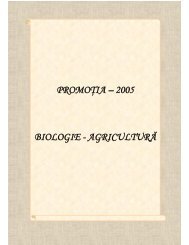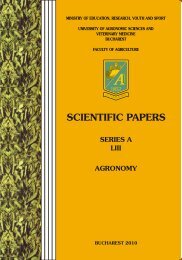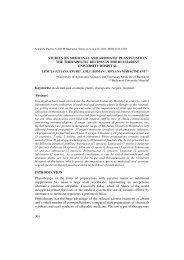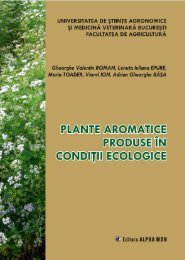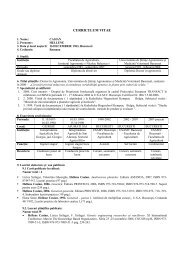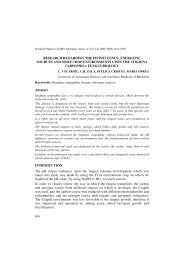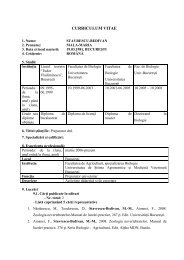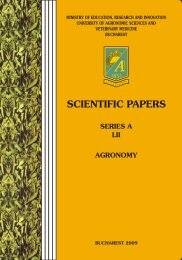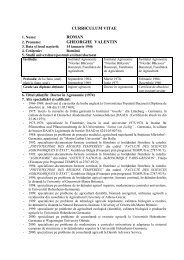MONOGENEA, PLATYHELMINTHES
MONOGENEA, PLATYHELMINTHES
MONOGENEA, PLATYHELMINTHES
You also want an ePaper? Increase the reach of your titles
YUMPU automatically turns print PDFs into web optimized ePapers that Google loves.
Scientific Papers, USAMV Bucharest, Series A, Vol. LII, 2009, ISSN 1222-5339<br />
CONTRIBUTION TO THE ZOOGEOGRAPHY OF THE GENUS<br />
OCTOMACRUM (<strong>MONOGENEA</strong>, <strong>PLATYHELMINTHES</strong>)<br />
MALA-MARIA STAVRESCU-BEDIVAN*, F.T. AIOANEI**<br />
*University of Agronomic Sciences and Veterinary Medicine of Bucharest<br />
**University of Bucharest<br />
Keywords: octomacrids, distribution map, Octomacum europaeum, Romania<br />
Abstract<br />
According to the latest specialist literature review, there are known six species of the genus<br />
Octomacrum, of which only one is European.<br />
This paper presents the geographic distribution map for the octomacrids and also some<br />
original photos of Octomacrum europaeum species, recorded in the Romanian fauna.<br />
INTRODUCTION<br />
The primary freshwater categority of monogeneans includes different taxa, some of<br />
them having a higher range and occuring strictly in the fresh water, but also some<br />
subfamilies strictly freshwater, even some genus of marine predominant families.<br />
The primary freshwater suborder Octomacrinea Khotenovsky, 1985 contains two<br />
families: Octomacridae, monotypic with holarctic distribution and Diplozoidae<br />
with euro-asiatic and afro-tropical distribution. The hole Octomacrinea suborder is<br />
more ancient in fresh water and hence has a higher significance than subfamilies<br />
such as Dactylogyrinae or Ancylodiscoidinae which are confined to fresh waters<br />
too, but are related to marine families [1].<br />
The family Octomacridae Yamaguti, 1963 has a single genus, Octomacrum, with a<br />
range including North America and Central Europe.<br />
This paper contributes to a better understanding the zoogeography of this genus, by<br />
introduction of all octomacrids species into a suggestive map.<br />
MATERIAL AND METHODS<br />
In our research we started from the list of monogeneans categories [1].<br />
By consulting a reach specialty literature, we reunite knowledges regarding the<br />
way of the octomacrids spreading in the actual ranges, the phylogenetic specificity<br />
and the freshwater fish host category, and hence we sketch a distribution map<br />
(figure 1).<br />
497
Fig. 1. Distribution map for the octomacrids: Octomacrum mexicanum, O. spinum, O. microconfibula,<br />
O. lanceatum, O.semotili, O. europaeum<br />
(the original blank map is taken from [12])<br />
498
We mentioned previously [11], the presence of the monogenean Octomacrum<br />
europaeum, find out into a phenomenon of competition manifested by negative<br />
interraction with Paradiplozoon alburni, in a sample of Alburnoides bipunctatus<br />
fish host.<br />
Some aspects of this parasite species are captured here in the photos bellow (figure<br />
2), made at trinocular microscope Novex Holland, with the help of the digital<br />
camera Panasonic Lumix DMC-LS60, 6 Mpx, 3x optical zoom.<br />
a<br />
b<br />
c<br />
Fig. 2. Octomacrum europaeum: a. general aspect of the body, opisthaptor<br />
(arrow) and ventral suckers (frame) (one division = 36 µ); b. the ventral<br />
suckers and pharynx (arrow) (one division = 3,6 µ); c. the anterior part of this<br />
monogenean, with the two ventral suckers (vertical arrows), the pharynx<br />
(orizonthal arrow) and the genital sucker (frame) (one division = 3,6 µ).<br />
499
The parasite biometry was recorded by the two micrometres proceeding, whith a<br />
preliminary calibration of the ocular micrometer for the each optical combination<br />
ocular-objective belonging to the microscope [10].<br />
RESULTS AND DISCUSSION<br />
There are known five species of the genus Octomacrum, with specificity for the<br />
Catostomidae and Cyprinidae host families [5]. But from the latest literature<br />
review, results the existence of six species, out of which only one is European:<br />
Octomacrum mexicanum, O. spinum, O. microconfibula, O. lanceatum, O. semotili<br />
and O. europaeum.<br />
The restricted octomacrids range is included inside the Diplozoidae, that is a more<br />
apomorphic and more warm adapted sister familiy. Prooctomacrids would have<br />
appeared on the common ancestor of cyprinids and catostomids in South-Eastern<br />
Asia. The octomacrids reached North America together with the catostomids. The<br />
second wave of migration was represented by cyprinids, that reached North<br />
America by Beringia in the Miocene; this host group did not carry however the<br />
diplozoids, more competitive forms. Prooctomacrids migrated from East Asia to<br />
Europe and Siberia together with the cyprinids, but here these parasites have been<br />
eliminated by diplozoids. Although the cyprinids occured in Africa since the end of<br />
the Miocene, the octomacrids did not penetrate here being less warm-adapted<br />
forms [1].<br />
Diplozoidae and Octomacridae are usually considered as sister families.<br />
Nevertheless, in 2002 a group of French researchers stated that the colonisation of<br />
primary freshwater teleosts by these two families could be independent. A<br />
molecular phylogeny was inferred by comparing newly obtained partial 28S and<br />
18S r DNA gene sequences [9].<br />
Athough Octomacrum lives in East and Central Europe only on the cyprinid<br />
Alburnoides bipunctatus, in nearctic things stay different. In North America were<br />
recorded five Octomacrum species, on catostomids and cyprinids fish [2].<br />
Octomacrum lanceatum parazites on Catostomus commersoni (Canada, Erie Lake)<br />
sau C. catostomus (Colorado) [4]; O. spinum, on Campostoma anomalum<br />
(Virginia) [4]; O. mexicanum was recorded on Algansea lacustris, into a mexican<br />
river [8]; O micronfibula parasites Notemigonus and other three cyprinid genus<br />
from Canadian lakes, while O. semotili was find on Semotilus and Chrosomus<br />
genus [4].<br />
O. europaeum is found in the Black Sea basin and was described for the first time<br />
in 1956 [7], on the branchae Alburnoides bipunctatus. Sice that moment, the<br />
parasite was recorded only the host cited before [2].<br />
In Czech Republic, Lucký (1957) describes O. europaeum as Discocotyle sagittata,<br />
but two years later the author further revised his identification, establishing the<br />
500
truth identity. The presence of Discocotyle monogenean species in cyprinids<br />
specimens was doubtful, specially because the salmonids are known within their<br />
regular hosts. Matějusova and Koubková rediscovered in 2000 Octomacrum<br />
europaeum, in the River Dyje from Czech Republic [5]. Octomacrum europaeum<br />
was cited also in few rivers from Poland [7].<br />
In Romania, the monogenean presence was recorded, after the discovery year by:<br />
Aioanei [2], Aioanei and Teodorescu [3], Stavrescu-Bedivan and Aioanei [11].<br />
CONCLUSIONS<br />
1. The present paper synthesizes by a map the zoogeographic data from<br />
specialty literature, regarding to Octomacrum species.<br />
2. There are known so far in the global fauna, the following octomacrids:<br />
Octomacrum mexicanum, O. spinum, O. microconfibula, O. lanceatum, O.<br />
semotili and O. europaeum.<br />
3. Octomacrum europaeum was recorded only on the cyprinid Alburnoides<br />
bipunctatus.<br />
REFERENCES<br />
1. Aioanei F., 1996. Continental and peripheral lineages of monogeneans in fresh<br />
waters. Trav. Mus. Hist. Nat. Grigore Antipa, vol. XXXVI (pp. 391-424).<br />
2. Aioanei F., 1999. Studiul sistematic, ecologic şi zoogeografic al unor grupe de<br />
paraziţi ai peştilor de apă dulce din România. Teză de doctorat, Inst. Biol. Acad.<br />
Române, Bucureşti (pp. 208).<br />
3. Aioanei F., D. Teodorescu, 2004. Some aspects of the competition in the hostparasite<br />
system. Ann. Univ. Buc., Anul LIII (pp. 81-88).<br />
4. Hoffman G.L., 1999. Parasites of North American Freshwater fishes. Second<br />
edition, Cornell University Press (pp. 539).<br />
5. Matějusová I., B. Koubková, 2002. Octomacrum europeum (Monogenea:<br />
Polyopisthocotylea) in Europe. Historical and recent perspectives. Parasitology<br />
Research, 88 (pp. 389-390).<br />
6. Prost M., 1993. Fish Monogenea of Poland. X.Parasites of Alburnoides bipunctatus,<br />
(Bloch). Acta Parasitologica, vol. 38, 4 (pp. 145-150).<br />
7. Roman E., B.E. Bychowsky, 1956. An interesting monogenean trematode<br />
Octomacrum europaeum n. sp. parazit. Alburnoides bipunctatus (Bloch) (in<br />
Romanian). Commun. Acad. R. P. R., 6 (pp. 901-904).<br />
8. Sánchez-Nava P., G. Salgado-Maldonado, E. Soto-Galera, B. Jaimes-Cruz, 2004.<br />
Helminth parasites of Girardinichthys multiradiatus (Pisces: Goodeidae) in the<br />
Upper Lerma River subbasin, Mexico. Parasitology Research, 93 (pp. 396-402).<br />
9. Sicard M., E. Desmarais, A. Lambert, 2002. Is the Octomacridae the sister familiy of<br />
the Diplozoidae? Parasite, 9 (pp. 85-87).<br />
501
10. Stavrescu-Bedivan Mala Maria, 2008. Contribuţii la sistematica, ecologia şi<br />
zoogeografia unor grupe de paraziţi la peşti dulcicoli din fauna României. Teză de<br />
doctorat, Univ. Bucureşti (pp. 285).<br />
11. Stavrescu-Bedivan Mala Maria, F. Aioanei, 2008. Noi date privind parazitofauna de<br />
monogene la Alburnoides bipunctatus (Cyprinidae) din Bazinul Someşului. Lucrări<br />
ştiinţifice U.S.A.M.V.B., Seria A, Vol. LI (pp. 991-996).<br />
12. ***http://grdc.bafg.de/servlet/is/15600/.<br />
502



